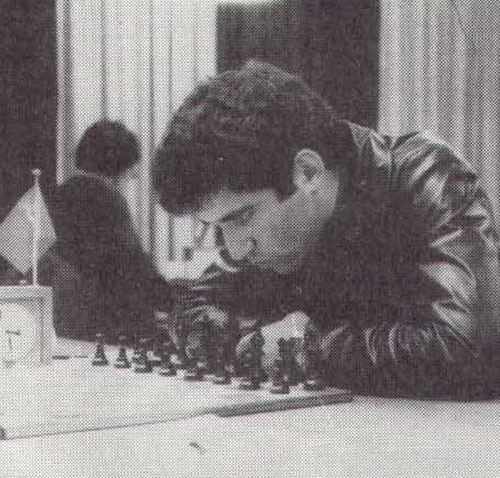The history of the game of chess knows around 30 players who have at some point exceeded the dream mark of 2600 Elo points. They are the "Super Grandmasters," of whom remarkably more than 60% are still alive today. This proves that over the years the general level of chess playing has increased. Perhaps the players of the past were as strong as those of today, but there have never been so many so strong.

World Champion Anatoly Karpov led the FIDE list in 1983 ...
In the last Elo list of the International Chess Federation (FIDE) there are 13 players with a rating of 2600 or more (in the previous list there were 16). For the first time since Bobby Fischer, an American, the young Yasser Seirawan, is represented in the illustrious group of super grandmasters. Germany's top player Robert Hübner, who was fourth on the previous list, was overtaken by Ljubomir Ljubojevic from Yugoslavia and the tough Swede Ulf Andersson. The runner-up Viktor Kortschnoi, who lost 35 Elo-points, dropped back considerably (from 3rd to 12th place). The rise of 20-year-old Garry Kasparov, on the other hand, seems to be almost unstoppable. He has now broken away from the rest of the field with 45 points. Only 20 points separate him and world champion Karpov.

... closely followed by upstart grandmaster Garry Kasparov
The 13 Supergrandmasters in the FIDE List are:
| 1 |
Anotoly Karpov |
USSR |
2710 |
+10 |
| 2 |
Garry Kasparov |
USSR |
2690 |
+15 |
| 3 |
Ljubomir Ljubojevic |
Yugoslavia |
2645 |
+30 |
| 4 |
Ulf Andersson |
Sweden |
2635 |
+25 |
| 5 |
Lev Polugajewski |
USSR |
2625 |
+15 |
| 6 |
Robert Hübner |
West Germany |
2625 |
–5 |
| 7 |
Mikhail Tal |
USSR |
2620 |
+10 |
| 8 |
Lajos Portisch |
Hungary |
2620 |
–5 |
| 9 |
Jan Timman |
Holland |
2605 |
+5 |
| 10 |
Tigran Petrosian |
USSR |
2605 |
-- |
| 11 |
Boris Spassky |
USSR |
2605 |
–5 |
| 12 |
Yasser Seirawan |
USA |
2600 |
+5 |
| 13 |
Viktor Korchnoi |
USSR |
2600 |
–35 |
In the women's singles, for the first time, a Western player is at the top: the very young Swedish player Pia Cramling has gained no less than 95 points and is considered an absolute super talent (she usually plays in men's tournaments and has already brought Viktor Kortschnoi to the brink of defeat).

No.1 in women's rating in 1983: 20 year old Pia Cramling from Sweden
Meanwhile the reigning world champion Maja Tschiburdanidse lost 30 points and has to share the top spot with three other players. Barbara Hund from Leverkusen, who last August became the first German player ever to win the title of "International Grandmaster of Women", is gratifyingly represented among the ten best in the ladies list:
| 1 |
Pia Cramling |
Sweden |
2355 |
+95 |
| 2 |
Nona Gaprindashvili |
USSR |
2355 |
+30 |
| 3 |
Nana Aleksandriia |
USSR |
2355 |
–15 |
| 4 |
Maya Tchiburdanidse |
USSR |
2355 |
–30 |
| 5 |
Alla Kuschnir |
Israle |
2330 |
-- |
| 6 |
Nana Ioseliani |
USSR |
2295 |
–30 |
| 7 |
Elena Akhmilovskaya |
USSR |
2290 |
–20 |
| 8 |
Marta Litinskaja |
USSR |
2275 |
-- |
| 9 |
Barbara Hund |
Germany |
2270 |
+65 |
The masters of creation view the rapid rise of the female elite with mixed feelings. It wasn't long ago that Fischer offered to spot the reigning world champion a full knight, which was already at that time quite a misjudgement (Tal said that the world champion would take the American apart, because "Fischer is Fischer, but knight is knight"). Today nobody would dare to give Cramling or Chiburdanidze a single pawn.

22-yer-old Women's World Champion Maia Chiburdanidze
The ladies are far undervalued terms of Elo. The world champion, called "Chib" by most tournament participants, walks around with 2355 Elo points, but clearly plays like a 2500 champion. Grandmaster Hort, who has already had unpleasant experiences, demands - half in fun - such undervalued ladies should be excluded from GM tournaments. The psychological advantage is too great when they play against men, who are confronted with such a situation once or twice a year at most. Some of his colleagues - “burnt children” - agree with the Czechoslovakian in all seriousness.
Current ratings
So let us see how things stand today (August 2020). I have counted a total of 237 players rated 2600 or higher. Of these 201 are rated between 2600 and 2700, 33 are rated between 2700 and 2800, and two rated over 2800 (Carlsen 2863 and Caruana 2835). Compare that to the 13 players rated over 2600 in 1983.
Among the women there are 104 players rated 2356 (peak rating in 1983) or higher, and eleven players rated 2500 or higher. There is one active player rated over 2600: Chinese GM Hou Yifan.



























